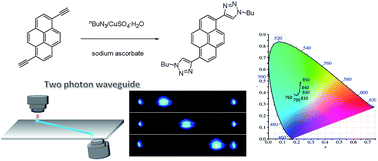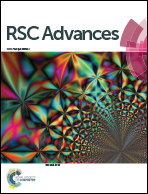Luminescence emission-modulated based on specific two-photon compound of triazole-conjugated pyrene derivative†
Abstract
A triazole-conjugated pyrene derivative (DTP) with strong two-photon absorption has been synthesized via CuAAC reaction. It can readily self-assemble into ultra-long 1D single-crystal nanowires by a one-step anti-solvent diffusion method, which exhibit exceptional two photon optical waveguides with low optical loss during light propagation. Single-particle spectroscopy of the nanowires clarifies that one short wavelength emission band results from the DTP monomer and the other longer wavelength band is responsible for the aggregate state of DTP. Moreover, DTP monomer and aggregate state emission peaks intensity of a single nanowire have opposite trends by changing the polarization of the incident light, owning to the two orthogonal optical transition dipoles. Besides, the excitation wavelength was changing from 760 nm to 850 nm, resulting in a red-shift of the maximum emission peak from 466 to 522 nm and the variation of the CIE coordinates from blue to green. This result may open up new perspectives in optoelectronic devices.



 Please wait while we load your content...
Please wait while we load your content...